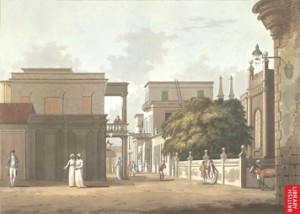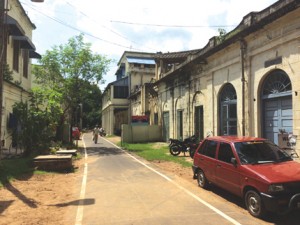Registered with the Registrar of Newspapers for India under R.N.I 53640/91
Vol. XXV No. 17, December 16-31, 2015
Know your Fort better
by Sriram V.
If you turn right as you come out of St. Mary’s Church, you will come across a small cordoned parking lot which houses the cars belonging to the Chief Minister’s cavalcade. Next is a platform of polished granite, a material that is incongruous with the rest of the fort but is sadly what is in vogue with all parties in power. You are now almost at the front of the Fort and there you need to turn right into a street that is still very impressive – filled with colonnaded buildings. A signboard informs you that you are in St. Thomas Street, also known as Snob’s Alley.
This is one of the oldest thoroughfares of the Fort. It gets its name in all probability from the fact that it stretches south, towards San Thome. In 1688, the East India Company ordered the preparation of a Rent Rowle of Dwelling Houses, Godowns & c, within the Garrison or Christian Town and as per this document, St. Thomas Street was among the best areas of the Fort, probably because it fronted the sea and therefore provided a good breeze.
This thoroughfare was then largely owned by Portuguese settlers within the Fort and had 21 houses and godowns in it. This community had built a church for itself near where the Namakkal Kavignar Maligai now stands (and of which more anon), and this appears to have been the house of prayer for the Christian fisherfolk who lived by the beach. It was then the practice for the funeral processions of these ‘macqua’ men to enter the Fort via St Thomas Gate and wend their way to the church via St Thomas Street. The Company honoured this practice and when residents petitioned that they be allowed to extend their houses on to the road space, it permitted them with the proviso that the passageway must in no way be impeded for the funeral processions. But even then there were changes afoot.
 Time Square, New York, also does its bit.
Time Square, New York, also does its bit.
In those early years, the Company had its hospital, which was built by public subscription, on this street, probably because of its favoured location in terms of sea breeze and morning light. In 1688, this building was acquired by the Government and converted into residential quarters for junior officers. It is described as large square edifice standing near the Rt Hon’ble Company’s Sorting Godown and St Mary’s Church and it was probably at the intersection of Church and St Thomas Streets. It also housed the first College of Fort St George, the institution being abolished in 1712. The building itself was demolished in 1719.
By 1701, St Thomas Street had become a fashionable thoroughfare, with buildings that could impress visitors. It became part of the processional route and when Daud Khan, then deputy to Nawab Zulfikar Ali Khan came on a visit, he was taken into Town by ‘Messrs Marshall and Meverell, the Streets being loin’d with soldiers from St. Thoma Gate up to the Fort, and the works that way man’d with the Marrein Company handsomely clothed with red coats and caps.’
The Town Hall shifted into St Thomas Street in 1688. This was originally in Choultry Gate Street, the northern counterpart of St Thomas Street, being diametrically at the opposite end and leading to what would eventually become Rajaji Salai. One of the most memorable events to be held at the Town Hall, while it was at St Thomas Street, was the establishment of the Corporation of Madras, on September 29, 1688, which makes our city’s civic body one of the oldest in the world. On the appointed day, the Corporation was inaugurated with all due solemnity, the Mayor and the Recorder taking their respective oaths, these being administered by the President (as the Governor of Madras was then known). Post this, the Mayor and Recorder administered oaths to the Aldermen and Burgesses. Among the Corporation’s many objectives was the building of ‘a Town Hall or Guild Hall.’ This took its time but was eventually built by 1697, during the governorship of Nathaniel Higginson, an American by birth and who in 1688 had become the first Mayor of Madras. Love identifies the new location as being ‘South of St Mary’s Church but on the opposite or east side of St Thomas’ Street.’ Paintings by Lambert and Scott dating to 1732 show this to be a lofty building with an ornate vaulted roof, surmounted by the cupola that terminates in a weather vane. This served as the Mayor’s Court and below it was the prison. The cost of construction came to 4000 pagodas and the Corporation, which had borrowed the money was burdened with an interest of 50 pagodas per month. The Councillors repeatedly represented about this expense to the Governor. The Corporation was finally assigned the scavengers duties in 1695 and with this, along with around 900 pagodas paid by the heads of various castes, the debt was repaid a year later.
 Snob’s Alley, then and now.
Snob’s Alley, then and now.
For all its loftiness, the Town Hall’s prison appears to have been most basic in character. There are accounts of prisoners complaining about the cramped conditions in which they were lodged. There were six cells, of which three were below the Town Hall and three more at the back or east side of the building, closer to the Fort entrance. By 1733, these along with the Town Hall itself, were considered to be in a ruinous condition. The entire premises was demolished in the 1750s, with a new Town Hall being put up once again on Choultry Gate Street. Today there is no trace of the old Town Hall on St Thomas Street.
Walking down St Thomas Street today, you cross on your right a building belonging to the Church. Next to it is the eastern façade of the Ex Servicemen Health Service Hospital, the western front of which is on Charles Street. Next to it is the Big Warehouse, dating to the 1720s. If you peer into this building, you will see vast rooms of at least 20 feet height, the roofs being supported by giant masonry pillars. The left side of St Thomas Street has similar buildings, all of them occupied by army health services. The first is the Nursing Sister’s House. Dating to the 18th century it has partially collapsed. Proceed till the end of the street and look at the very dilapidated three storey structure that stands on the left. Known as the Last House on Snob’s Alley, this is historically significant, for it is the oldest house in the Fort, probably of the same vintage as the old Fort House that is now enclosed within the Assembly building. Last House is in a shockingly bad state of preservation, its doors and windows having long gone and its various floors being propped by casuarina supports. The Archaeological Survey is supposed to be protecting this monument but of that there are no signs.

Immediately after Last House is an empty plot of land. This was where the first Post Office of Madras once stood. Cross over this area towards the east and you will find yourself standing on the front rampart of the Fort, with a fantastic view of Rajaji Salai and the harbour. Look carefully below and you will see several underground chambers, all filled with debris. If only these were cleaned up and could be explored.
Opposite Last House is a thick growth of vegetation. Inside this are the ruins of the Chaplain’s House. This was where the chaplains of St Mary’s once lived. By the 1940s the building was no longer a residence and was used to display the silver plate and records of the Church. When these were shifted to the Fort Museum the building was abandoned and it collapsed a few years ago.
It is not clear as to when St Thomas Street became known as Snob’s Alley. Given that no historical record before the 1920 mentions this, the name appears to be of relatively recent origin, chiefly because the senior officers of the army resided here till Independence.

